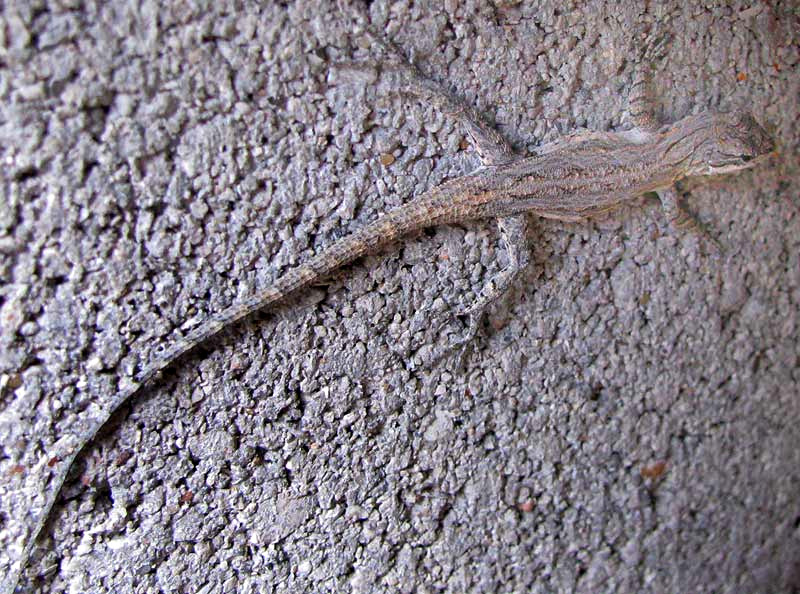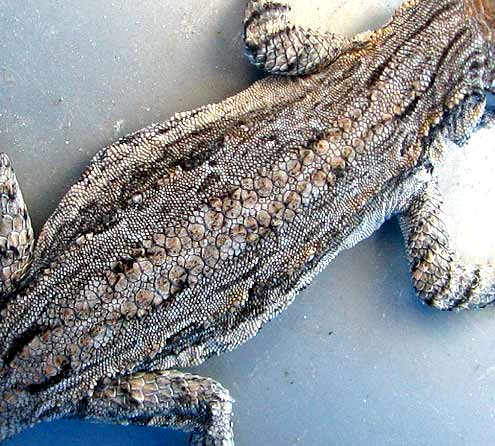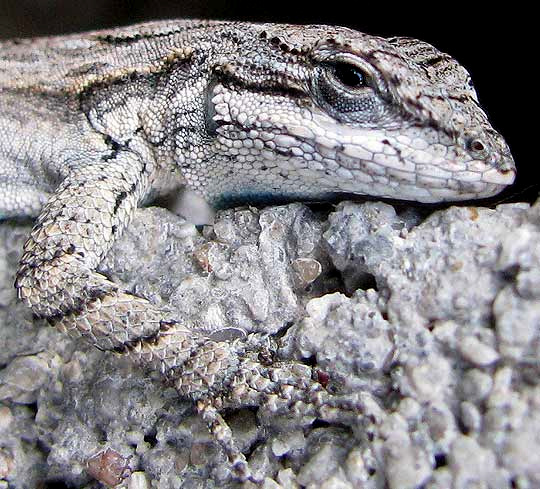Excerpts from Jim Conrad's
Naturalist Newsletter

from the September 1, 2013 Newsletter issued from the Frio Canyon Nature Education Center in the valley of the Dry Frio River in northern Uvalde County, southwestern Texas, on the southern border of the Edwards Plateau; elevation ~1750m (~5750 ft); N29.62°, W99.86°; USA
TREE LIZARD
During my year here I got the impression that the only lizard species I was likely to see were the Texas Spiny Lizard and the Texas Spotted Whiptail, both commonly encountered. However, during the last two weeks suddenly three new-for-me species have turned up, including the five-inch one (12cm) found one afternoon in the dry bottom of a plastic tub used for catching water. I feared he was unable to scale the tub's smooth walls so I turned the tub onto its side. The lizard instantly scurried off, but instead of hiding he mounted one of Juniper House's foundation cinderblocks, paused, looked at me, and let me get close enough for a good look at him.
I'm glad he did because I thought he was just another Texas Spiny, but finally it dawned on me that he was different. Above, you can see him clinging to the cinderblock. In that picture you can see that something unusual is going on, on the lizard's back. The usual systematic scale arrangement seems to give way to some kind of broken pattern. A closer look at the back is shown below:

Notice that two lines of much enlarged scales run down the back, separated by a thin, pale line of smaller scales over the backbone. These two lines of big scales take us directly to the Ornate Tree Lizard, UROSAURUS ORNATUS. If it weren't for the oversize scales, identification might have been hard because otherwise our lizard is pretty similar to others found in our area.
This was an exceptionally tame little critter who indulged a nice close-up of his face:

Last week we looked at the Greater Earless Lizard. In this picture you can see what ears can look like on a normal lizard -- in this case a vertical slit between the eye and shoulder.
Ornate Tree Lizards occupy trees, rocks, fence posts and buildings from southeastern California north to southern Wyoming to here in southwestern Texas, and adjacent arid northern Mexico. Occupying so many far-flung habitats, the species is fracturing into various subspecies -- about ten currently recognized.
In Joan Roughgarden's 2004 book Evolution's Rainbow: Diversity, Gender, and Sexuality in Nature and People, this lizard's sexuality was revealed as being more complex than normal. For one thing, male Ornate Tree Lizards may display different "genders" of different colors and with different hormonal profiles. Roughgarden writes that when a male tree lizard hatches an abundance of progesterone causes him to develop into an orange-blue type. Low progesterone leads to an orange type. During dry weather, orange-type males' corticosterone levels increase, which causes testosterone to decrease, which encourages a nomadic lifestyle. Orange-blue types don't display this hormonal response to the weather, and remain in their territories regardless of climatic conditions.